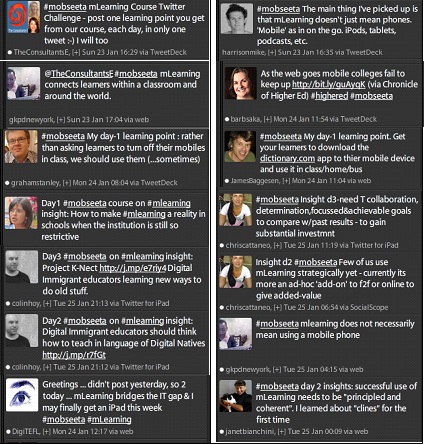[Reflections on an online training course]
 Three days ago, Penny Hum´s class was conducting a physics experiment to investigate lenses. She spotted a pair of students using a mobile phone so went over to check. They were using the screen as an object, trying to see if they could create an image from it. She didn´t tell them to put the phone away. “They were clearly more engaged by using the phone in their practical than using the lamp I had provided” she says. “Both students were surprised when I not only allowed then to continue to use the phone, but chatted to them about [our mLearning course] and how I was learning how to bring more mobile technology into the classroom. I had a longer discussion with those 2 students than I have ever elicited from them before”.
Three days ago, Penny Hum´s class was conducting a physics experiment to investigate lenses. She spotted a pair of students using a mobile phone so went over to check. They were using the screen as an object, trying to see if they could create an image from it. She didn´t tell them to put the phone away. “They were clearly more engaged by using the phone in their practical than using the lamp I had provided” she says. “Both students were surprised when I not only allowed then to continue to use the phone, but chatted to them about [our mLearning course] and how I was learning how to bring more mobile technology into the classroom. I had a longer discussion with those 2 students than I have ever elicited from them before”.
Penny is one of 267 participants on the free online course mLearning: an Introduction, which I´m running for SEETA (South Eastern Europe Teachers Associations). Penny is based in the UK, and is one of 267 participants from 58 countries (I counted).
This was my first experience of running an online course with such a large group of people. Our own online courses have a group maximum of 15! And that´s a big group for us! So to have almost 20 times that number has been a bit of a shock. But, as is typical in MOOCs, the level of lurking (after the first flurry of introductions) has been fairly high, and communication has tended to revolve around a core group of around 30 – 40 participants who post and interact daily. I personally have no problem at all with lurking. I think it is equally valid learning activity for many participants. And it made reading and replying to forum postings more manageable for everyone.
The course has run for exactly 7 days, with one short task of approximately 30 to 45 mins per day. The vast majority of the participants are busy full-time language teachers. I have been simply stunned by the level of engagement shown by the participants, and the high level of discussion and thinking that goes on. Like Penny, several of the participants have had eureka moments.
During the course, those of us who are regular users of Twitter have been using #mobseeta (mob as in large group, and mob as in mobile – very cunning) as our hashtag. On Day 1 of the course I set the following twitter challenge: to post one learning point/insight gleaned from the course daily, in just one tweet. Here are some of them!
The course is one week long, and we are nearly finished. The turnout has been quite astonishing. I really did count the countries the participants come from – there are 58. I’m not sure we’ve quite reached the status of a MOOC*, but we´re a pretty large bunch! Perhaps we´re a mini-MOOC.
[*a Massive Open Online Course – these can typically run into the thousands of participants on one course. More on MOOCs here.]
Overall working with such a large group has been a fantastic experience for me. I have learnt a huge amount about a wide variety of teaching contexts, and have come in contact with some very good teachers. I´ve also been privileged to witness teachers like Penny having insights and new experiences in their classrooms, which they have chosen to share with us. And the huge (to me) number of participants hasn´t actually turned out to be as draining as I thought. Within minutes of the course starting, participants were interacting and communicating, offering suggestions and advice, and generally supporting each other. I suspect I could have been run over by a bus on Day 2, and no one would have noticed I was missing 🙂 And that is definitely the hallmark of a successful (mini-) MOOC. Thank you to all who have taken part!
[Note: This free SEETA Intro to mLearning course is open and available to anyone, for the foreseeable future. I hope it will be a useful resource for those interested in the basics of mLearning, and specifically how mLearning relates to (English) language teaching.]
Nicky Hockly
The Consultants-E
January 2011


Great post which captures the learning and excitement of the course!
I feel so lucky to have heard about this via Twitter and @janetbianchini ‘s blog post and then privileged to have been allowed to take part from, not SE Europe, but SE Australia!
Nicky, you’ve been a fabulous facilitator, and have managed the crowd control very well. I’m sure we would have noticed if you’d gone AWOL on Day 2, but you’re right in that the conversations have become rather feral, so it may have taken us a bit of time to notice 🙂
I’m kind of glad it’s only a week, I don’t think I could manage to keep up this pace much longer – I need to work and sleep! Looking forward to connecting with you and lots of those 267 feeling #mobseeta people tonight (my time) in real time.
Cheers, Lesley
Thanks for your comments Lesley, and really glad you enjoyed the course. Thanks also for attending our final video chat! The link to the recording for that is now available in the course itself, in the Day 7 block. I enjoyed it immensely!
Hi Nicky
It’s truly been a fantastic course and you have summarised it so well in this post. I’ve really got a lot out of it and it’s definitely made me feel much more curious about exploring the different avenues available. Slowly but surely, I’ll be reviewing the course contents over the next few weeks. I’ll be taking more notes in order to help me to consolidate the huge amount of information and resources shared by everyone this past week. As Lesley says, I’m glad it’s only a week, but the after effects are going to be long lasting.
The course has been an eye-opener for me! I feel it has been a perfect introduction to show us what options are currently available to teachers and what also lies ahead in terms of various handheld devices and applications. I have learned a lot via the forums. I found the sharing of practical ideas and discussions to be very useful.
A very big thank you to you, Nicky, for organising everything so efficiently. This course has come at a very timely moment. It has served as a bit of a wake-up call for me, as it’s made me fully aware that mLearning is not just a passing phase. It’s definitely here to stay. I’m a bit more ready for it than I was 7 days ago, and that is a great feeling!
It’s been lovely to meet so many teachers from around the globe, all sharing the same objectives. That’s been fun!
Thank you, Janet – it’s been a pleasure having you as one of the participants!
Dear Nicky,
This course has been kind of new blow into my teaching. I also have told about mLearning to my colleagues and students and they seem very eager to use some apps.
Thank you for great learning time we spent in the course. As teaching is a non stop learning process this week has been very productive. I hope I’ll be able to apply newly learnt skills!
Thanks to everyone who contributed ideas and shared experience!
Very glad you found our mini-course useful, Gulshan, and I’m especially delighted to hear that you have been sharing some of these new ideas with your colleagues and students 🙂
Hi Nicky, and Lesley, Janet and Gulshan…
It was great to work with you on the mLearning course and like you learnt a lot. It’s good to see that Nicky was experiencing something new too and all being in in the same or similar boat felt reassuring somehow 🙂
THANKS NICKY!
I concord with everything said above – your blog post really captures the course atmosphere. I also agree also about your constant and supportive moderation. You had praise and encouragement for everyone equally and enough energy to read through every post however long or short and I think that fostered an increasing sense of freedom to participate.
THANKS NICKY!
There were streams of ‘latecomers’ too! Your relaxed attitute towards lurkers meant that people felt free to join in or just read through. I know that it took me a while before I began tweeting, began writing anything online. I think it might be the same with beginning to use mLearning strategically – we’ll have to get through the ad-hoc (discrete) stage first.
I began a new course yesterday, and in my needs analysis included questions about mLearning and the devices they had….. Off we go….
THANKS AGAIN NICKY!
Chris
Hi Chris, thanks for your kind comments! I’m just thrilled to read that the course prompted you to include an angle on devices/mLearning in your latest course needs analysis – this is exactly what makes it all worth while for me 🙂 Do please let me know how things go if you try out anything you’ve picked up from the course, okay? I would love to hear about it.
You can bet on it ! 🙂